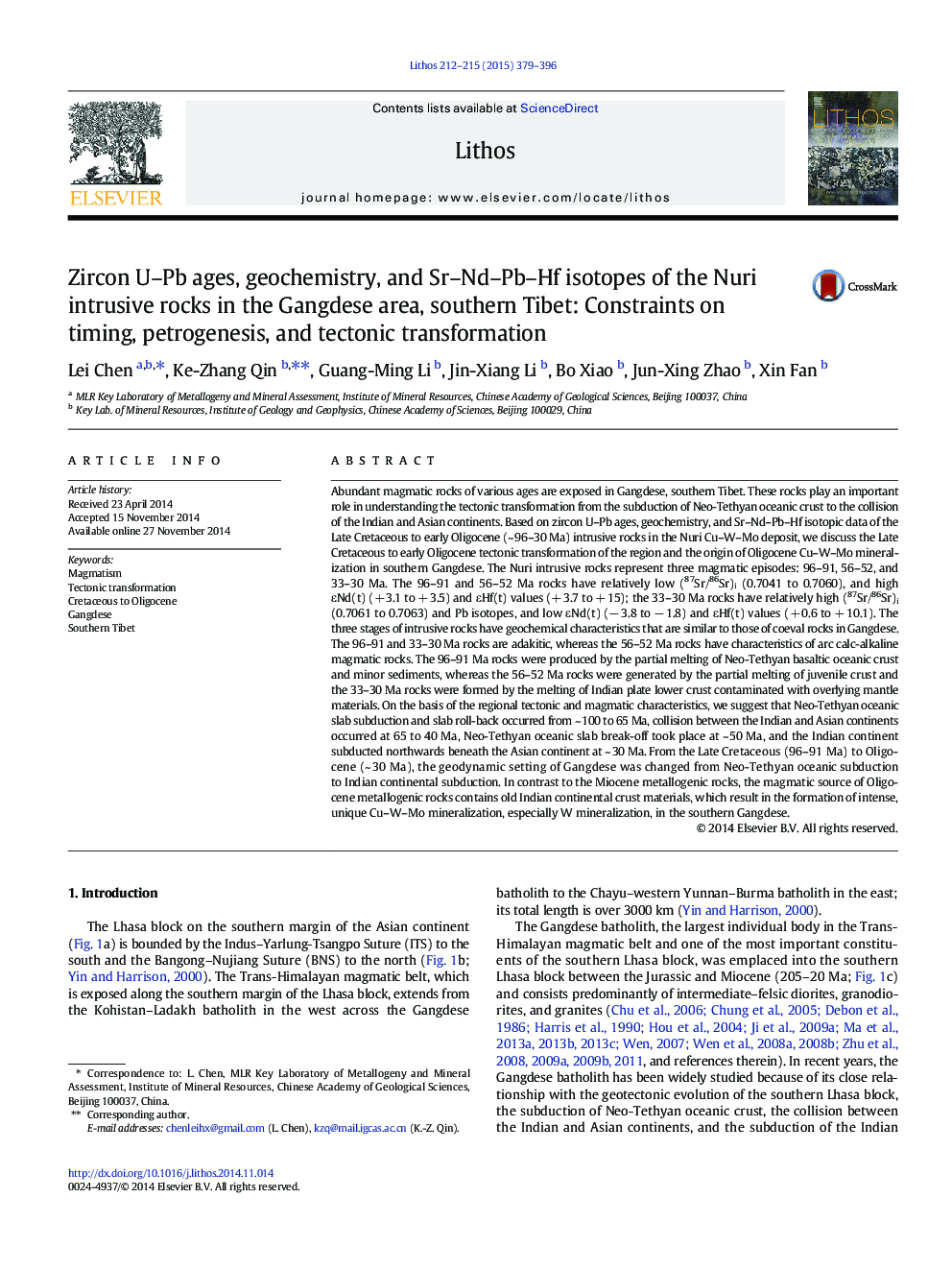| کد مقاله | کد نشریه | سال انتشار | مقاله انگلیسی | نسخه تمام متن |
|---|---|---|---|---|
| 4715808 | 1638669 | 2015 | 18 صفحه PDF | دانلود رایگان |
• The intrusive rocks in Nuri are formed in 96–91, 56–52, and 33–30 Ma.
• 96–91 Ma adakitic rocks were formed by Neo-Tethyan oceanic slab subduction.
• 56–52 Ma rocks are related to the initial collision of Indian and Asian continents.
• 33–30 Ma adakitic rocks were formed by the northward subduction of Indian continent.
Abundant magmatic rocks of various ages are exposed in Gangdese, southern Tibet. These rocks play an important role in understanding the tectonic transformation from the subduction of Neo-Tethyan oceanic crust to the collision of the Indian and Asian continents. Based on zircon U–Pb ages, geochemistry, and Sr–Nd–Pb–Hf isotopic data of the Late Cretaceous to early Oligocene (~ 96–30 Ma) intrusive rocks in the Nuri Cu–W–Mo deposit, we discuss the Late Cretaceous to early Oligocene tectonic transformation of the region and the origin of Oligocene Cu–W–Mo mineralization in southern Gangdese. The Nuri intrusive rocks represent three magmatic episodes: 96–91, 56–52, and 33–30 Ma. The 96–91 and 56–52 Ma rocks have relatively low (87Sr/86Sr)i (0.7041 to 0.7060), and high εNd(t) (+ 3.1 to + 3.5) and εHf(t) values (+ 3.7 to + 15); the 33–30 Ma rocks have relatively high (87Sr/86Sr)i (0.7061 to 0.7063) and Pb isotopes, and low εNd(t) (− 3.8 to − 1.8) and εHf(t) values (+ 0.6 to + 10.1). The three stages of intrusive rocks have geochemical characteristics that are similar to those of coeval rocks in Gangdese. The 96–91 and 33–30 Ma rocks are adakitic, whereas the 56–52 Ma rocks have characteristics of arc calc-alkaline magmatic rocks. The 96–91 Ma rocks were produced by the partial melting of Neo-Tethyan basaltic oceanic crust and minor sediments, whereas the 56–52 Ma rocks were generated by the partial melting of juvenile crust and the 33–30 Ma rocks were formed by the melting of Indian plate lower crust contaminated with overlying mantle materials. On the basis of the regional tectonic and magmatic characteristics, we suggest that Neo-Tethyan oceanic slab subduction and slab roll-back occurred from ~ 100 to 65 Ma, collision between the Indian and Asian continents occurred at 65 to 40 Ma, Neo-Tethyan oceanic slab break-off took place at ~ 50 Ma, and the Indian continent subducted northwards beneath the Asian continent at ~ 30 Ma. From the Late Cretaceous (96–91 Ma) to Oligocene (~ 30 Ma), the geodynamic setting of Gangdese was changed from Neo-Tethyan oceanic subduction to Indian continental subduction. In contrast to the Miocene metallogenic rocks, the magmatic source of Oligocene metallogenic rocks contains old Indian continental crust materials, which result in the formation of intense, unique Cu–W–Mo mineralization, especially W mineralization, in the southern Gangdese.
Journal: Lithos - Volumes 212–215, January 2015, Pages 379–396
